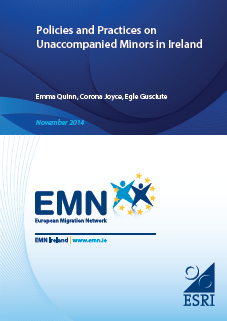 There has been significant improvements in the care of unaccompanied minors in Ireland, but challenges persist in a lack of national oversight and regional variations in care.
There has been significant improvements in the care of unaccompanied minors in Ireland, but challenges persist in a lack of national oversight and regional variations in care.
This new report explores the policies and practices in place regarding non-EU unaccompanied minors. Unaccompanied minors[1] are broadly defined as children aged under 18 years who are not in the care of, or accompanied by, a responsible adult. Between 2010 and 2013 over 380 unaccompanied minors were referred to the specialist TUSLA Social Work Team for Separated Children in Dublin.
Key findings
The model of care, including accommodation, provided to unaccompanied minors is now much improved:
- Since 2010 there has been an end to hostel-based care for unaccompanied minors, a system that was widely criticised as exposing already vulnerable children to harm.
- TUSLA now treats unaccompanied minors equally to other children in care, meaning that they are provided with foster care, supported lodgings or residential placements. Due to the high level of need among this group, the majority are allocated a social worker.
- There has been a decrease in the number of unaccompanied minors going missing from State care: in 2007, 41 children went missing from the care of the Dublin social work team of which 12 were found, while in 2013, 4 children went missing and 2 were found.
Certain key challenges remain:
- There is no targeted national strategy for unaccompanied minors. National oversight of care provision to this group is limited and variations in care are in evidence:
- Several different sections of the Child Care Act 1991 are used to take unaccompanied minors into TUSLA care. The decision on which section to apply is taken locally and may impact on the minor’s legal guardianship.
- Key data and information gaps persist, for example, in the total number of unaccompanied minors in care in the State, although progress towards national-level data is underway.
- Social workers reported practical difficulties arising from the lack of a clear immigration status for many unaccompanied minors, including difficulties accessing a Personal Public Service Number or travelling outside the State, for example on a school trip.
- Some ambiguity exists as to who has the statutory responsibility for determining the age of unaccompanied minors, although a high level of cooperation on age assessment is reported by the agencies involved.
- The experience of unaccompanied minors reaching 18 years of age varies; those who have made an asylum application may enter the direct provision system. Regional disparities exist in aftercare provision, which depends on local resources and practices.
Commenting on the findings, report author Emma Quinn said:
“This study charts significant improvements to the model of care provided to unaccompanied minors in Ireland since publication of a previous EMN Ireland study on this subject in 2009. Good practices, including child-specific procedures, are in evidence within the asylum system. Also welcome is the practice of not forcibly returning unaccompanied minors. However, in the context of the increasing numbers of asylum applicants in Ireland and across the EU, it is timely to ensure that service provision to this particularly vulnerable group is robust and that national oversight exists”.
EMN Ireland together with the UNHCR Ireland, will hold a half-day conference on Protection of Unaccompanied Minors and Separated Children in Ireland and Europe on Thursday, 27 November 2014. For more information see: www.emn.ie/emn/nationalnetwork.
For more information:
Download Policies and Practices on Unaccompanied Minors in Ireland.
- An unaccompanied minor is defined as: “…a third country national or stateless person below the age of eighteen, who arrives on the territory of the Member States unaccompanied by an adult responsible for them whether by law or custom, and for as long as they are not effectively taken into the care of such a person, or a minor who is left unaccompanied after they have entered the territory of the Member States” (EMN Glossary 2.0).

